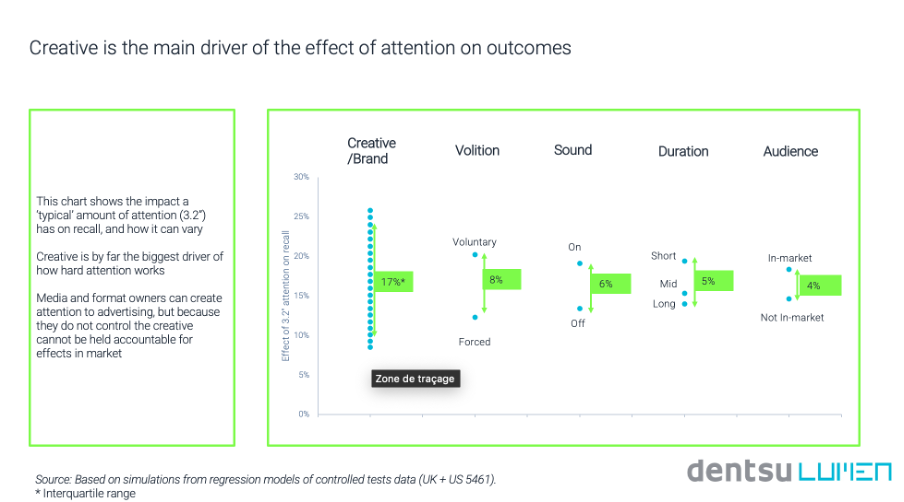By Caroline Hugonenc, Global VP Insights & Research, Teads
There has been a long understanding that current methods to measure the effectiveness of digital marketing aren’t up to the task. For more than a decade, viewability has been the standard to measure the quality of impressions but there is consistent evidence that the focus should be on attention.
The ‘attention’ given to viewability means that all impressions have been considered equal — whether or not any notice has actually been paid to an ad. Although this has given the industry a minimum benchmark for what brands should be paying for, it has meant there is a race to the bottom, with smaller ads being crammed into webpages to satisfy viewability metrics. This has come at the detriment of both consumer experience and media planning alike.
Driving the Attention Economy
In the latest research to support attention, Teads collaborated with dentsu to look into the ‘Attention Economy’. Attention data was collected from a mobile panel of 3,005 users in the UK and US, in parallel with a controlled test of 801 users, to measure the impact of attention on branding KPIs.
The study found that attention is three times better at predicting outcomes than viewability, while showing that viewability alone is not enough to measure the effectiveness of ads. And, interestingly, some drivers of viewability, such as format size and position on the page, can have a negative impact on attention level.
When it comes to attention itself, the metric is driven within a few paradigms. There needs to be a distinction between content that users engage with and content that just so happens to be on the same page people are looking at. For instance, a premium publisher has more of an opportunity to engage a person while they are reading an article than any ad within an endless scroll, social media, environment.
However, while this is the case, it’s important that the content is both quality and viewable. Quality content can drive higher engagement and, in turn, lead to ads being in view for in excess of 12 seconds.
Furthermore, earned attention is far more effective at delivering results than when attention has been acquired by force. When consumers voluntarily view an ad, there is a significantly higher impact on brand metrics than ads that have been forced upon them, whatever the length of time they view the ad for.
Creative is Key
Then there’s creativity — one of the great talking points around advertising. As an industry, we are well-aware of the impact that good creative has on the effectiveness of advertising overall but it is also worth looking at to measure its impact within the ‘Attention Economy’.
The variation between a good creative and bad creative can be as much as 17 percentage points when it comes to brand recall. Moreover, in A/B testing, optimized ads drove 49% higher attention, on average, than the original versions of ads.
The final key thing to consider when it comes to attention is how relevant ads are to consumers. It’s human nature to engage with information that we find interesting — whether that’s through engaging creative or contextual relevance.
In terms of the latter, ads placed within a relevant context to the user were found to provide an uplift of attentive seconds per 1,000 of 13%. To further support this, research from Integral Ad Science (IAS) and Neuro-Insight showed that, when ads were contextually aligned, there is a 23% lift in memory of a particular ad.
To dive deeper into this, we’re working with Havas Media Group to analyse the factors that have an impact on user engagement with editorial and attention. Titled ‘Project Trinity’ the research will look at more than 15 factors, such as publisher layout and context, ad formats and saturation and readership demographics, across several of the top 200 media properties in the US and UK. The aim is to help publishers to create a better user experience and boost revenues, while, in turn, increasing media effectiveness for advertisers.
A combination of this research and earlier studies will continue to prove that focusing on attention is the best way to measure the effectiveness of marketing. These insights should be eye-opening for the industry and show us what needs to be done to achieve higher-quality media and improved creative effectiveness. There should now be little doubt that attention is the best way to quantify the value and quality of ad impressions.
Paying Attention
When it comes to planning and optimizing for attention, it’s important to evaluate how your media partner performs on attention. This can be done through auditing of media partners using controlled environments, passive panels or live campaign measurement.
It’s also imperative to evaluate how creative can be optimized for attention by pre-testing ads with facial coding or eye-tracking measurement. In addition, you should be testing different buying modes and reporting on attention metrics and linking attention level to impact.
Journeying through all of these steps will ensure that you have the means to use attention as a metric and unlock insights into the true effectiveness of your marketing.









